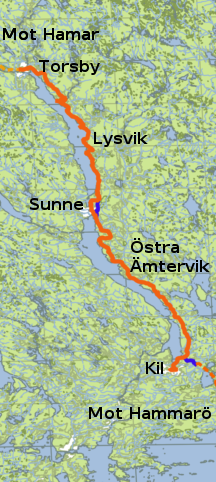Lysvik
Lysvik ligger vid Frykens östra strand ungefär mittemellan Sunne och Torsby. I Lysvik finns kyrka, vandrarhem, hembygdsgård, och camping.
När du lämnat Öjenäs kommer en raksträcka på landsväg. Efter ungefär 3 km kommer du fram till den gamla prästgården, numera galleri. Där tar du av till vänster och följer en liten väg som passerar en ny milsten. Sedan kommer du ut på genomfartsleden genom byn.
Kort därefter går du över Fryksdalsbanan, järnvägen som invigdes 1915. Efter ytterligare några hundra meter passerar du Mormors glasscafé, som är inrymt i den vackra, gamla missionskyrkan. På höger sida har du sedan skolan och lite längre in ligger en förskola.
Till vänster ligger Lysviks kyrka som började byggas 1753 och stod färdig 1762. Tornet däremot är från 1901. Dopfunten är från 1200-talet och kommer från den första sockenkyrkan i Lysvik. Rolf Edberg som skrivit många böcker om miljöhotet och tidigare varit landshövding i Värmland, ligger begravd på Lysviks kyrkogård.
Efter kyrkan svänger du till vänster på Strandvägen. På höger hand ligger ett hus som fram till 1930-talet var gästgiveri. Efter ett litet tag är du framme vid badstranden, där det finns camping, stugor till uthyrning och en sommarrestaurang med båtkänsla. Från stranden kan du vid klart väder se kyrktornen i både Sunne och Torsby. Som en kuriositet kan nämnas att från bryggan går en kyrkbåt över till andra sidan, till Bjälverud, som är en del av Lysviks socken. Kyrkbåten kan beställas för en tur av privatpersoner.
Direkt du kommer ut på genomfartsleden igen har du gården Lund på höger sida och på den gården ska Lysviks första sockenkyrka från 1200-talet ha legat. Strax därefter passerar du keramikern SolSiegs ateljé och är nu framme vid Ransbyviken. I viken har det tidigare legat två sågverk och under 1940-talet sysselsatte sågarna ett 70-tal personer. På norra stranden där ån Lysan rinner ut i Fryken, lär den allra första kyrkan, en stavkyrka från 1100-talet ha legat. Där ligger också Kyrkkällaren och gärdet kallas än idag för kyrkgärdet.
Strax efter stenen, där det står att vägen byggdes som nödhjälpsarbete 1922-1924, viker du av mot hembygdsgården. Lysviks hembygdsgård låg först på andra sidan vägen från kyrkan sett och var från 1846 den första skolan i byn. På helgerna fungerade skolan som sockenstuga. 1932 byggdes en ny skola och i samband med detta fick hembygdsföreningen ta över gården. Den flyttades först till kyrkans mark för att 1983 flyttas till nuvarande plats. På gården ligger också Lysviks första handelsbod från 1848. Ett antal stenyxor som hittats i åkrar längs med leden från hemmanet Bäcken i söder till Ö:a Berga i norr, finns utställda på andra våningen i hembygdsgården. Vid Västra Berga fann man 1880 under odlingsarbete en 10 cm lång spjutspets från bronsåldern. Vid Östra Berga har en stenyxa påträffats.
Berga gård, som idag är vandrarhem, drivs sedan 1982 i hembygdsföreningens regi, och har en lång historia. Gården nämns i jordeboken från 1540. Mellan 1643 och 1730 var Berga prästgård. Den nuvarande huvudbyggnaden uppfördes 1804. 1904 köptes Berga av Lysviks kommun och fungerade som ålderdomshem fram till 1975. I samband med kommunsammanslagningen med Sunne kommun byggdes det nya ålderdomshemmet, Sjövik. Sjövik, som numera har både vanliga hyreslägenheter och ett serviceboende för äldre, ligger i viken där sågarna tidigare legat. Då du lämnar hembygdsgården lämnar du också de mer centrala delarna av Lysvik och får läsa mer under Vålberga/Skönberga.
Kommunikationer
Buss 202 mellan Sunne och Torsby via Lysvik stannar i Ivarsbjörke och andra mindre orter efter vägen.I Sunne, Lysvik och Torsby finns både buss(202) och tåg(74)förbindelser.
Se Värmlandstrafik för mer information.
Övernattning
- Det går bra att tälta (i enlighet med allemansrätten) på Uddeberg
- I Öjenäs finns åretruntöppna Hollandsåsens B&B hos den nederländska träkonstnären Trudy Colijn, 070-682 11 47
- I Skäggegård, i korsningen där vägen viker av mot Lysvik centrum, ligger Galleri Prästgården och sommartid finns det en stuga att hyra hos Jörgen Byh och Anna Ohlsson, tel 070-255 17 28.
- I Lysvik finns camping med stugor vid Frykens Pärla och ett åretruntöppet vandrarhem på Berga gård.

